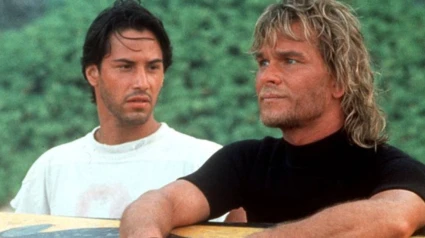Point Break (1991): The Ultimate Ride of Adrenaline, Brotherhood, and Moral Conflict
Point Break, directed by Kathryn Bigelow and released in 1991, is more than just an action movie — it’s a visceral, adrenaline-fueled exploration of loyalty, identity, and the dangerous allure of living on the edge. With unforgettable performances from Keanu Reeves and Patrick Swayze, stunning stunt work, and a spiritual undertone rarely found in the genre, Point Break has rightfully earned its place as a cult classic and one of the most iconic action films of the '90s.
The story follows Johnny Utah (Keanu Reeves), a rookie FBI agent and former college football star, who is assigned to infiltrate a gang of daring bank robbers known as the "Ex-Presidents" — so named because they wear masks of former U.S. presidents during their heists. The investigation leads Utah into the world of extreme sports, where he meets the charismatic and philosophical surfer Bodhi (Patrick Swayze). As Utah becomes increasingly drawn into Bodhi’s world of surfing, skydiving, and spiritual freedom, the line between law enforcement and friendship begins to blur.

Patrick Swayze’s performance as Bodhi is the soul of the film. Bodhi is more than just a criminal — he’s a modern-day outlaw, a thrill-seeking philosopher who believes in pushing the limits of the human experience. His magnetic energy and love for the ocean make him a compelling figure, and his chemistry with Reeves is electric. Their dynamic transforms Point Break from a standard cops-and-robbers movie into a story of emotional depth, philosophical tension, and existential questioning.
Keanu Reeves delivers a perfectly measured performance as Johnny Utah — cool, vulnerable, and gradually torn between his duty and his admiration for Bodhi’s lifestyle. As he falls deeper into Bodhi’s world, Utah begins to question not only the morality of his mission but also the nature of freedom, risk, and control.
What sets Point Break apart is Kathryn Bigelow’s direction. She treats the action sequences with realism and intensity, emphasizing physicality and immersion. The surfing scenes are beautifully shot, conveying the raw power of the ocean, while the skydiving sequences are exhilarating, offering a real sense of weightlessness and danger. The film’s most famous set piece — the foot chase through backyards and alleyways — is still studied today for its raw energy and handheld urgency.

Thematically, Point Break explores duality — order vs. chaos, safety vs. freedom, law vs. loyalty. It doesn’t glorify crime, but it understands the seductive nature of breaking free from societal constraints. Bodhi isn’t just robbing banks; he’s making a statement about living life without compromise. And in chasing him, Utah must confront not just a criminal, but his own limits and convictions.
In conclusion, Point Break is a unique action film — one that combines pulse-pounding stunts with introspective character development and mythic undertones. It asks questions about purpose, identity, and what it means to truly live. More than 30 years after its release, it continues to resonate, not just for its quotable lines or iconic sequences, but for its deeper emotional and philosophical core. It’s not just about catching the bad guys — it’s about catching the wave.



